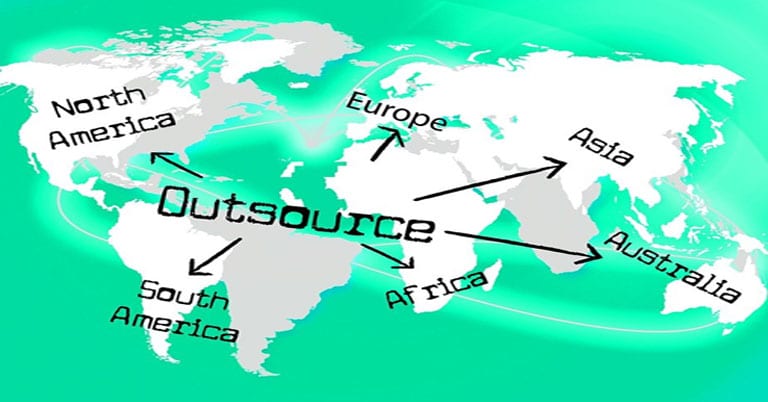Technology is closing the gap between teams and helping them collaborate effectively despite being physically apart. This has created tremendous opportunities for IT outsourcing. IT outsourcing allows businesses to delegate tasks to other teams and lessen the burden on their teams, allowing them to focus on core competencies.
What makes software development and IT-related services ideal for outsourcing is its intangible nature. You don’t always need an internal team to create a good product. Several teams can work simultaneously on one IT project with ease.
IT outsourcing is offered in three ways; namely, offshoring, onshoring and nearshoring. The location of the outsourcing resource is what differentiates all of them. With so many ways to outsource your work, choosing the best IT outsourcing technique is difficult, especially, if all sources offer the same skill level.
In this article, we will break down the differences in onshore vs. offshore vs. nearshore and help you choose the ideal IT outsourcing strategy for your business.
Offshore Outsourcing
Offshore outsourcing allows you to leverage talent in distant countries. For a team in the US or Europe, offshore development teams may reside in a range of regions from India, China, the Philippines, and Pakistan. Since offshore IT teams are in a different continent than yours, they help you expand your reach to all corners of the world and access the best talent.
Perhaps, the best-known advantage of offshore software development is its extremely low cost. Instead of hiring an entire IT team full of programmers, testers, businesses analysts, designers, writers, UI/UX experts, and of course, Managers, you only have to pay for a single service.
You not only hire highly skilled professionals at a discounted rate, but also save money in capital costs, recruiting and training costs, and countless operational costs. Moreover, hiring the right offshore development team means you can work with experienced developers who can deliver in tight deadlines.
Lastly, you can easily divide the workload to ease pressure on your team. Doing so can help you complete multiple projects simultaneously with ease.
However, the difference in time zones can be challenging for some businesses. However, you can easily counter by aligning them with your time zone, or setting a schedule that is suitable for both you and them.
Likewise, you can also address the apparent gap in communication by delegating tasks to your appointed manager. Alternatively, you can leverage agile methodologies like scrum to keep the offshore team accountable throughout the development phase. Establishing daily, weekly, fortnightly, and monthly goals can also help you manage work more effectively.
Read: Offshore software Development: 5 Advantages You Must Know
Onshore Outsourcing
Onshore outsourcing is hiring resources within the same country as yours. An onshore team is the closest to you in terms of distance. For a company in the US, an onshore team will be working in the US and will always be available to you.
The biggest advantage of working with an onshore team is that you can work in your own time zone. In other words, you don’t have to wake up long hours just to communicate with your team. Since an onshore team will always be easily accessible to you, you can share ideas and conduct meetings with a moment’s notice.
Working with your fellow countrymen eliminates any cultural or language barriers and makes it significantly easier to address concerns within your team, coordinating and collaborating with them much more effectively.
Most importantly, it is far easier for you to manage onshore teams. If you want to track progress of your project, you can appoint a person from your team to work collaboratively with your team. Likewise, you can also conduct training sessions to familiarize the onshore teams with your requirements, helping you build a better product in terms of quality.
However, what an onshore team offers in convenience, it takes back in costs. Onshore outsourcing is the most expensive type of IT outsourcing. Your onshore team will demand similar work rates as your own internal team. Therefore, if you are looking to cut your costs, an onshore team might not be the best option.
Nearshoring
Nearshoring offers a blend of both onshore and offshore outsourcing but fails to offer any unique benefit. In nearshore outsourcing, you will hire outsourced resources from a region near you.
This means, those countries will be in the same continent as yours. If you are in the US, a nearshore team will be in Mexico, or Canada; even countries in South America, like Argentina or Uruguay.
Similarly, for businesses in the UK, France, or Germany, a nearshore IT outsource company will be in the Eastern part of Europe in countries like Ukraine, Moldova, Serbia, and even Turkey. Although nearshore companies offer cheaper services compared to an onshore service, they are still more costly than services offered by offshore companies.
To learn more about the differences between nearshoring vs. offshoring, visit our blog on the benefits of both practices.
Conclusion
IT outsourcing relieves burden from your team and allows you to leverage the expertise of high-skilled workers from other teams. If you don’t want any language or cultural barriers and are looking for teams you can collaborate easily, then onshore services are the best for you.
On the other hand, offshore software development allows you to acquire a highly skilled team at the fraction of the usual cost. Nearshore outsourcing offers a bit of both. However, the margin of benefit is not significant enough to make much difference.




